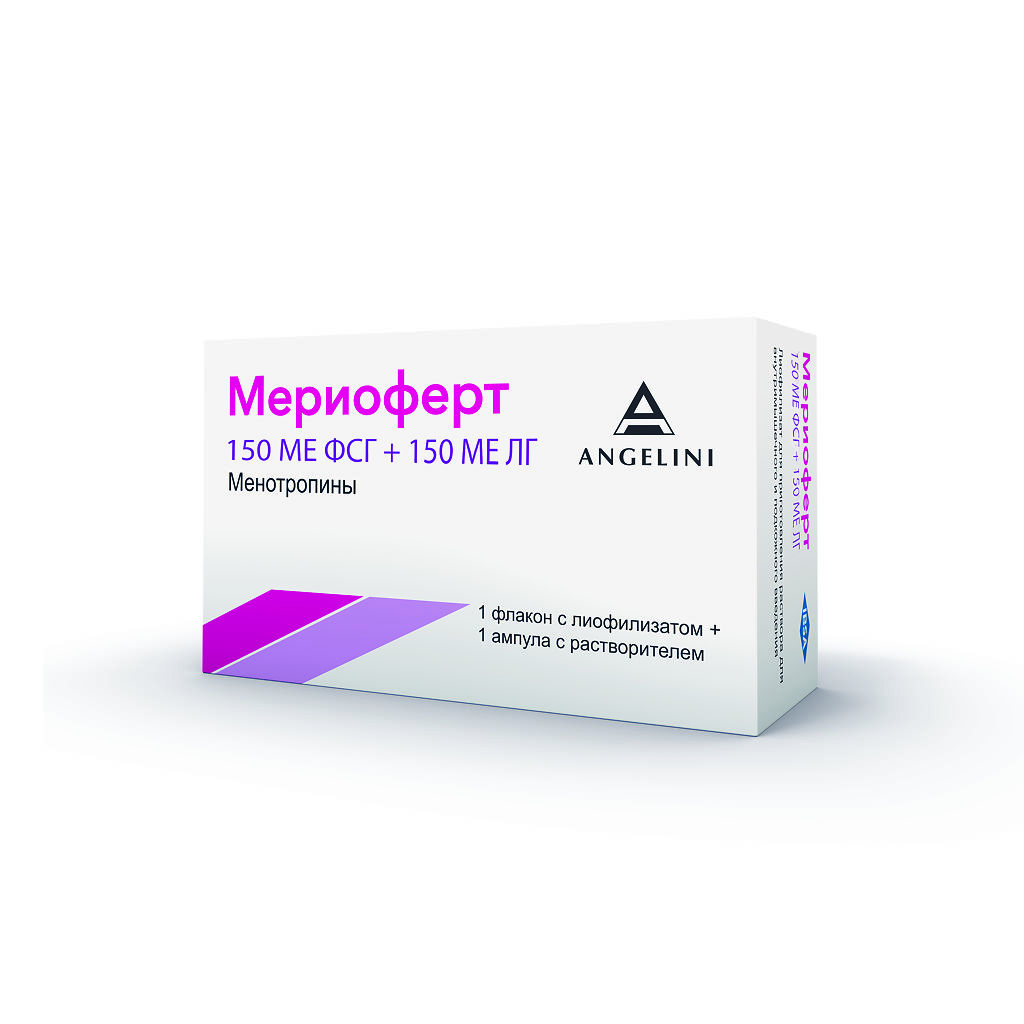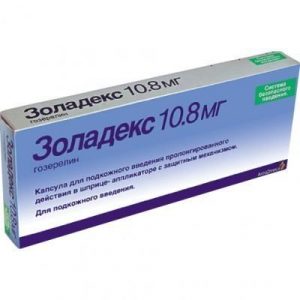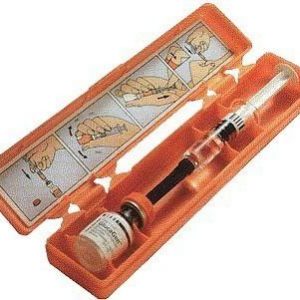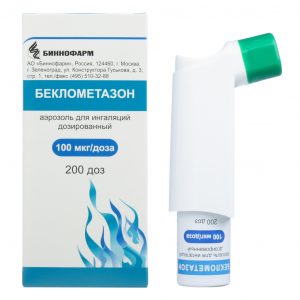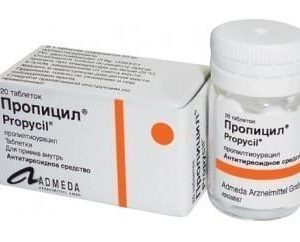Description
Pharmacological action
The drug Meriofert is a drug of high purity human menopausal gonadotropin (hMG). It belongs to the group of menotropins. The ratio of the biological activity of follicle-stimulating hormone (FSH) and luteinizing hormone (LH) is 1: 1. The drug is obtained from the urine of postmenopausal women.
Specific gonadotropin receptors are present only in the tissues of the genital organs. In the ovaries, LH binds to receptors on the surface of theca cells and the corpus luteum, as well as to granulosa cells of large follicles.
FSH binds to receptors on the surface of granulosa cells of small follicles in the ovaries and Sertoli cells in the testes.
In women, the drug Meriofert stimulates the growth and maturation of ovarian follicles, increases the concentration of estrogens, and stimulates the proliferation of the endometrium. In men, it stimulates spermatogenesis with azoospermia and oligoasthenospermia.
Contraindications
– Hypersensitivity to menotropin and other components of the drug.
– Pituitary or hypothalamic tumors.
– Decompensated thyroid disease, adrenal insufficiency, hyperprolactinemia.
– Age to 18 years.
In women:
Persistent ovarian enlargement, ovarian cysts (not caused by polycystic ovary syndrome).
Anomalies in the development of genital organs incompatible with pregnancy.
Uterine fibroids incompatible with pregnancy.
Vaginal bleeding of unknown etiology.
Estrogen-dependent tumors (ovarian cancer, uterine cancer or breast cancer).
Primary ovarian failure.
Pregnancy and the period of breastfeeding.
In men:
Prostate cancer, testicular tumor, androgen-dependent tumors.
Primary testicular failure.
Caution: Presence of risk factors for thromboembolic complications, such as an individual or family predisposition, severe obesity (body mass index> 30 kg / m2), or thrombophilia, since in this case there is an increased risk of venous or arterial thrombosis and thromboembolism during or after the use of gonadotropins. In this case, the benefits of treatment with gonadotropins should exceed the risk of their use.
Recommendations for use
The drug Meriofert is administered intramuscularly or subcutaneously with a periodic change in the place of administration. A subcutaneous route of administration is preferable since it provides the greatest absorption of the drug substance. Therapy with Meriofert should be carried out only under the supervision of a doctor who has the appropriate specialization and experience in the treatment of infertility.
The solution is prepared immediately before injection using the supplied solvent. The doses of the drug described below are given in FSH and are the same for both the subcutaneous and intramuscular route of administration.
In women, the dose of the drug is set individually depending on the reaction of the ovaries. This requires monitoring of the response of the ovaries to the therapy in the form of ultrasound (ultrasound) in combination with the determination of the concentration of estradiol in the blood plasma.
Anovulation (including PCOS for clomiphene therapy failure).
Meriofert may be administered daily. The use of the drug should begin during the first 7 days of the menstrual cycle. The recommended initial dose is 75-150 IU / day. In the absence of a sufficient ovarian reaction, the dose gradually increases. The recommended interval for increasing the dose should be at least 7 days. The recommended increasing dose is 37.5 ME, but not more than 75 ME. The maximum daily dose usually does not exceed 225 ME. If the therapeutic effect is not achieved within 4 weeks of treatment, the injection of the drug Meriofert is stopped, and then begin a new cycle with a higher dose of the drug. The patient is recommended to use barrier methods of contraception or abstinence from sexual intercourse until the onset of menstruation.
When an adequate ovarian response is achieved the day after the last injection of Meriofert, 5000-10000 IU of hCG is administered once to induce ovulation. The patient is recommended to have sex on the day of hCG administration and the day after administration. As an alternative method, intrauterine insemination is possible.
In case of excessive ovarian reaction, the administration of the drug Meriofert must be stopped and the administration of hCG should be refused.
Treatment should be resumed in the next cycle at a lower dose than in the previous cycle.
Controlled ovarian hyperstimulation to induce the growth of multiple follicles during assisted reproductive technology (ART).
The widely used protocol for hyperstimulation involves the administration of 150-225 IU of the drug Meriofert daily starting from 2 or 3 days of the menstrual cycle and continuing until sufficient follicle sizes are achieved. The correction of the daily dose is carried out in accordance with the patient’s response to therapy. The daily dose of the drug should not exceed 450 ME FSH.
24-48 hours after the last injection of Meriofert, one injection of hCG is prescribed at a dose of 5000 ME-10000 ME to induce the final maturation of follicles.
Gonadotropin releasing hormone agonists (aHnRH) are currently widely used to prevent the release of endogenous LH. In this case, the use of
Meriofert should be started approximately two weeks after the start of treatment with GnRH agonists. In the future, both drugs continue to be used together until an adequate level of follicular development is achieved. The dose of the drug Meriofert is adjusted in accordance with the reaction of the patient’s ovaries.
In case of hypogonadotropic hypogonadism in men, Meriofert is prescribed to stimulate spermatogenesis if previous therapy with hCG drugs caused only an androgenic reaction without signs of increased spermatogenesis. In this case, treatment continues by administering 2000 ME hCG 2-3 times a week, along with injections of Meriofert (75 ME or 150 ME) 2-3 times a week. Treatment according to this scheme should be continued for at least 3 months.
If there is no positive effect during this time, treatment can be continued for up to 18 months.
Special instructions
Treatment should be carried out under the supervision of a doctor who has experience in the treatment of infertility.
Before starting the use of Meriofert, it is recommended to conduct an examination to detect hypothyroidism, adrenal insufficiency, hyperprolactinemia, pituitary or hypothalamic tumors, as well as appropriate specific treatment.
OHSS
OHSS is a syndrome different from uncomplicated ovarian enlargement, the manifestations of which depend on the severity. It includes a significant increase in the ovaries, a high concentration of estrogen in the blood serum, as well as an increase in vascular permeability, which can lead to the accumulation of fluid in the abdominal, pleural and, less often, pericardial cavities (with severe OHSS). The following symptoms are observed for moderate OHSS: abdominal pain, bloating, significant ovarian enlargement, weight gain, shortness of breath, oliguria, and gastrointestinal symptoms, including nausea, vomiting, and diarrhea. In severe OHSS, hypovolemia, hemoconcentration, electrolyte disturbances, ascites, hemoperitoneum, hydrothorax, acute respiratory distress syndrome and thromboembolic complications develop.
An excessive ovarian reaction to the administration of gonadotropins rarely leads to the development of OHSS unless hCG is administered to stimulate ovulation. Therefore, in the case of ovarian hyperstimulation, HCG should not be administered, and the patient should be warned to refrain from sexual intercourse or to use barrier methods of contraception for at least 4 days. OHSS can progress rapidly (within 24 hours to several days), becoming a serious medical complication, so patients should be observed for at least 2 weeks after hCG administration. Compliance with the recommended doses of Meriofert, the mode of administration and careful monitoring of therapy can minimize cases of ovarian hyperstimulation and multiple pregnancy. When performing ART, aspiration of the contents of all follicles before ovulation can reduce the risk of developing OHSS.
OHSS can be more severe and protracted during pregnancy. Most often, OHSS develops after cessation of treatment with gonadotropins and reaches its maximum severity within 7-10 days after treatment. Usually, OHSS occurs spontaneously after the onset of menstruation.
In patients with moderate to severe OHSS, the patient is hospitalized and specific therapy is started.
PCOS occurs with high frequency in patients with polycystic ovary syndrome.
Multiple pregnancy.
In multiple pregnancies, there is an increased risk of adverse maternal and perinatal outcomes. With the use of menotropins, a multiple pregnancy develops more often than with a natural conception. In the case of in vitro fertilization (IVF), the probability of multiple pregnancy depends on the number of embryos introduced, their quality and age of the patient. The patient should be warned of the potential risk of multiple pregnancy before starting treatment.
Pregnancy Complications.
The frequency of spontaneous abortions during pregnancy following treatment with Meriofert is higher than in healthy women.
Ectopic pregnancy.
With a history of fallopian tube diseases, both during natural conception and in the treatment of infertility, women have a high risk of ectopic pregnancy. The prevalence of ectopic pregnancy after IVF is from 2 to 5% compared with 1 to 1.5% in the general population.
Neoplasms of the reproductive system.
There are reports of neoplasms of the ovaries and other organs of the reproductive system, both benign and malignant, in women, who underwent infertility treatment using several ART techniques. It has not yet been established whether treatment with gonadotropins increases the initial risk of these tumors in women with infertility.
Congenital malformations
The prevalence of congenital malformations of the fetus when using ART is slightly higher than during natural conception. It is believed that this may be due to the individual characteristics of the parents (mother’s age, sperm characteristics) and multiple pregnancy.
Thromboembolic complications
Women with known risk factors for thromboembolic complications, such as an individual or family predisposition, obesity (body mass index> 30 kg / m2) or thrombophilia may have an increased risk of venous or arterial thromboembolic complications during or after treatment with gonadotropins. In such cases, the benefits of their use should exceed the risk.
It should be borne in mind that pregnancy itself also increases the risk of thromboembolic complications.
In men with a high concentration of FSH in the blood (which indicates primary hypogonadism), Meriofert is usually ineffective.
Impact on the ability to drive transp. Wed and fur.: Meriofert does not affect the ability to drive vehicles and mechanisms.
Composition
1 vial with lyophilisate contains:
Active ingredient – highly purified human menopausal gonadotropin hMG (menotropin) 75 ME FSH + 75 ME LH, 150 ME FSH + 150 ME LH.
Auxiliary component – lactose monohydrate 10.00 mg
1 ampoule with solvent contains: sodium chloride (pyrogen-free for injection) 9 mg, water for injection up to 1 ml.
Side effects of
Undesirable side reactions observed when taking the drug were in most cases moderate and transient.
The most common adverse reactions were: the formation of ovarian cysts, reactions at the injection site and headache (with a frequency of up to 10%). The most serious adverse reactions were OHSS and complications associated with this syndrome.
The main adverse reactions are listed in the table below:
Adverse adverse reactions were classified as follows: very frequent ( 1/10) frequent – ( 1/100 to 1/10) infrequent – ( 1/1000 to 1/100) rare – (from 1 / 10000 to 1/1000) are very rare – ( 1/10000).
Organs and systems
Frequency
Adverse reaction
From the gastrointestinal tract
Often
Gastrointestinal syndrome, including nausea, vomiting, diarrhea, intestinal colic and bloating, abdominal pain
Very common
administration General disorders and disorders Pain, redness, bruising, swelling and / or irritation at the injection site
From the nervous system
Very often
Headache
Violations of the genitals and mammary gland
Very often
Ovarian enlargement and ovarian cyst formation
Often
Ovarian hyperstimulation syndrome (men)
Rarely
Ovarian torsion
Cardiovascular
Very rare
Thromboembolism
Immune
Very rare
Systemic allergic reactions such as skin redness and skin rash . Quincke’s edema
From the skin and subcutaneous tissue (in men)
Often
Acne
Overdose
In case of overdose, the development of OHSS and thromboembolic complications is possible. Symptoms of OHSS include ovarian enlargement, lower abdominal pain, nausea, vomiting, diarrhea, weight gain, oliguria, ascites, hydrothorax, hemoperitoneum, blood concentration, shortness of breath (for more information, see Special instructions). Symptoms of OHSS of mild or moderate severity usually do not require additional treatment and disappear on their own within 2-3 weeks. With severe OHSS, hospitalization is required in the intensive care unit of specialized gynecological hospitals for complex treatment.
Storage conditions
Store at a temperature not exceeding 25 ° C in a dark place.
Reconstituted solution should be used immediately.
Keep out of the reach of children.
Expiration
2 years.
Active ingredient
Menotropin
Terms and conditions
prescription
injectable dosage form
injection
